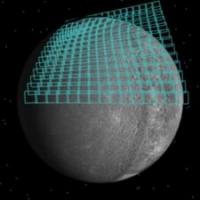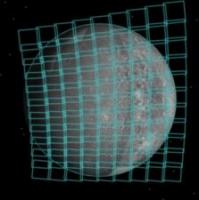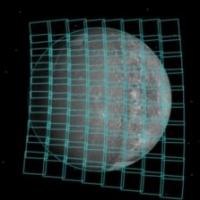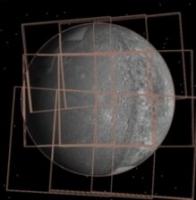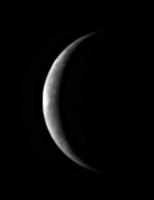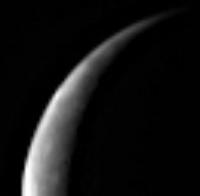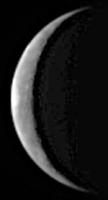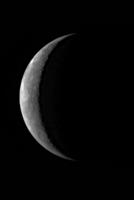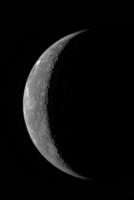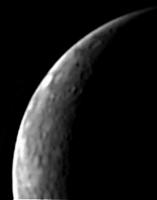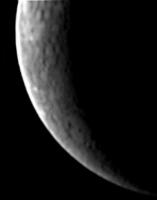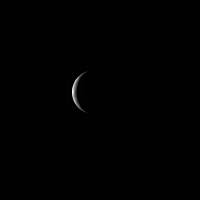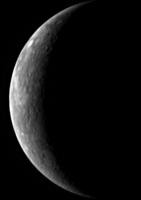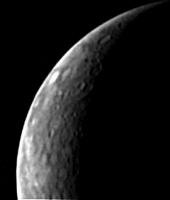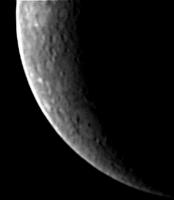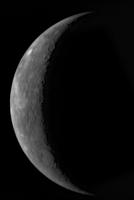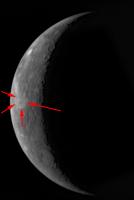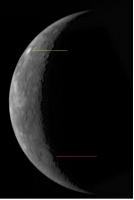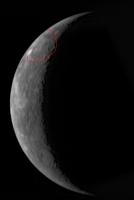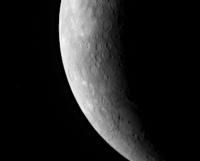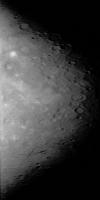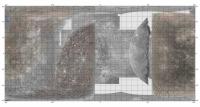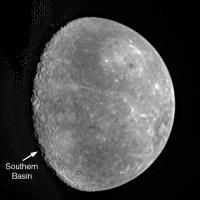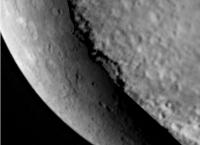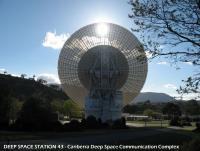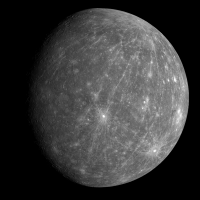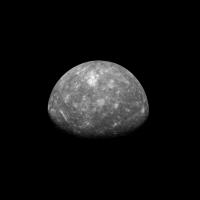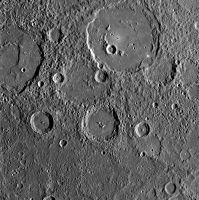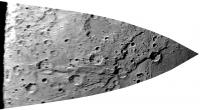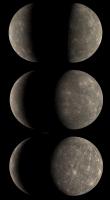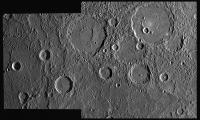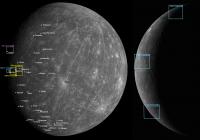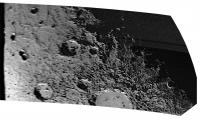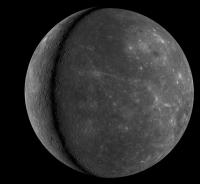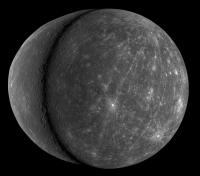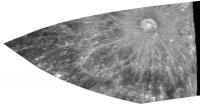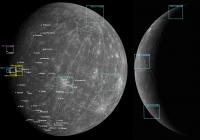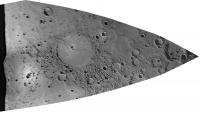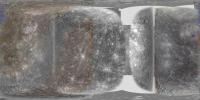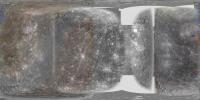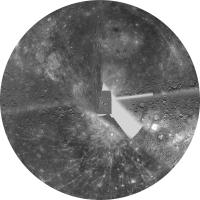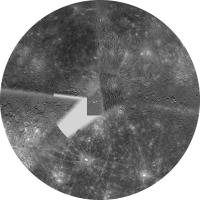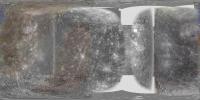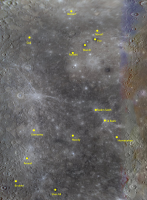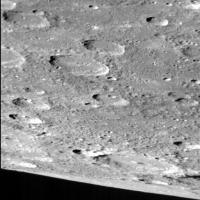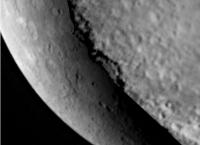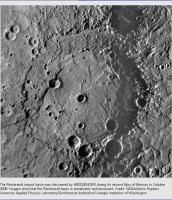Printable Version of Topic
Click here to view this topic in its original format
Unmanned Spaceflight.com _ Messenger _ Mercury Flyby 2
Posted by: Holder of the Two Leashes Feb 8 2008, 10:50 PM
It is time for this new topic.
http://messenger.jhuapl.edu/news_room/details.php?id=90
Posted by: As old as Voyager Feb 8 2008, 11:02 PM
One interesting feature MESSENGER will get a good look at during the second flyby is the area of Mercury's surface dubbed 'Weird Terrain.'
This jumbled region of the planet's surface is antipodal to Caloris and marks the focal point of seismic waves generated by the impact.
Mariner 10 only saw half of this disturbed region, so I'm looking forward to seeing just how much havoc Caloris wreaked on the other side of Mercury.
I wonder if a good look at the Weird Terrain will yeild any new info about Mercury's interior? (at least at the time of the Caloris impact).
Posted by: Decepticon Feb 9 2008, 02:28 AM
Do we get any polar regions imaged during any of the flybys?
Posted by: Dominik Feb 9 2008, 03:26 AM
That's something I'm also interested in ![]() .
.
Posted by: CAP-Team Feb 9 2008, 10:41 AM
I think you'll have to wait for that till the orbital insertion.
Posted by: tasp Feb 9 2008, 02:35 PM
I recognize there are some controversial views regarding the Deccan Traps and the Yucatan impact on earth.
Perhaps study of Caloris/weird terrain on Mercury might help us understand possible analogous structure(s) on earth ??
I also note, flyby 2 will be flown ~ 1 mile per second slower than flyby 1.
More time for pictures and other goodies!
Posted by: tty Feb 10 2008, 01:38 AM
That idea is simply not on for two good and sufficient reasons:
1. Deccan was not antipodal to Chicxulub 65 MY BP.
2. The Deccan Traps started ereupting well before the K/T boundary as proven by Maastrichtian fossils in the Intertrappan beds.
tty
Posted by: JRehling Feb 10 2008, 04:53 AM
The flybys are all near-equatorial and, moreover, they are so close to the planet that the poles are permanently over the horizon near C/A.
Yet moreover, the interesting thing about the poles, that the bottoms of the craters may contain ice, is by definition something that can't be observed in sunlight, because they're never in sunlight. So far as Mariner 10 showed, there was nothing unusual in the visible areas of the poles.
The interesting thing will be to see the elemental spectroscopy of the north pole where any hydrogen would make a strong signal (as it did on the Moon and Mars). That will have to wait for the orbital mission. The other possibility is that some other element like sulfur is the culprit. I'm betting on ice, though, which would mean that every body in the inner solar system besides Venus has water ice at its poles. Come to think of it, it's probably about a sweep in the outer solar system, too, besides Io.
Posted by: Mariner9 Feb 11 2008, 04:26 PM
I was reading an article on Spacedaily, and ran across this real mathematical puzzler:
"Observations during this second Messenger flyby will almost complete the first high-resolution viewing of Mercury, adding another one-third of the planet surface to the 21% of territory not seen by Mariner 10 and first imaged by Messenger in January 2008," says Messenger Project Scientist Ralph McNutt.
I'm scratching my noggin over this one.
He appears to be saying: Mariner 10 + Messenger Flyby 1 = 21% unimaged, aka. 79% coverage.
But if you add another 33% coverage, you get 112% coverage, which can't be correct.
Or, perhaps: Mariner 10 + Messenger Flyby 1 = 79% Coverage. Of the 21% left unimaged, Flyby 2 will get 1/3 of that missing coverage, aka 7%, so the total coverage will go up to 86%.
Anyone want to chime in?
Posted by: JRehling Feb 11 2008, 05:52 PM
Mariner 10 viewed 45% of Mercury. By these numbers, Flyby 1 added 21% and Flyby 2 added 33%, summing to 99%. That works. I think 33% is a bit of an overstatement, but speaking in fractions, 29% could be the real figure, giving a total of 95%.
I still think that's an overstatement, or at least it includes areas on the limb which aren't really being effectively resolved, but the gist is that we'll see more new stuff this time than we did last time. And when it's done, we'll have viewed the great majority of Mercury's surface.
The catch is that it looks totally different depending on phase angle, so we're going to have to see everything at least twice before we've really seen it. But the orbital mission will ace that assignment.
Posted by: Phil Stooke Feb 11 2008, 11:23 PM
I'm pretty sure it means 33% of the blank area. There should still be a sizeable strip left to fill in after Flyby 2, and Flyby 3 will not add anything much to it. That will have to wait until orbit.
Phil
Posted by: Holder of the Two Leashes Jul 10 2008, 03:14 PM
Just one year (88 earth days) to go. ![]()
Posted by: Holder of the Two Leashes Sep 7 2008, 03:23 AM
MESSENGER is solar sailing its way in to Mercury, according to http://messenger.jhuapl.edu/news_room/details.php?id=102.
Things should start to pick up in earnest soon.
Posted by: Greg Hullender Sep 7 2008, 11:09 PM
Although flyby #2 largely covers territory already imaged by Mariner 10, I think the resolution should be much better. Also, as JR implies, seeing it at a different phase angle ought to tell us a good bit as well.
It's flyby #3 that may be hard to get excited about. A bit slower, a slightly different phase angle, but otherwise pretty much a repeat of flyby #1. But maybe we'll get lucky and see something cool anyway.
--Greg
Posted by: dilo Sep 8 2008, 12:09 AM
This is a very exciting navigational technique, at least until a true solar sail will be developed... I wonder if is really new or if someone used it in previous missions?
Posted by: Holder of the Two Leashes Sep 8 2008, 01:00 AM
Apparently this is the first time the technique has been used to steer a spacecraft's trajectory. Mariner 4 had solar pressure vanes as an experiment to help control attitude, with mixed results. Mariner 10 successfully adjusted its attitude with solar pressure, which extended its life. But we are talking here about adjusting course.
Posted by: dmuller Sep 8 2008, 12:44 PM
With the second flyby now just a month away, I have started to dig for events etc for my realtime simulation, and as always I am getting different times for the same events. I guess the closest approach time has not been inked in, but I thought I'd share my initial results anyway.
All times are Spacecraft Event Times in UTC:
Mercury closest approach (altitude 200km) on 6 Oct 2008 between 08:40 and 08:42
Horizons currently has closest approach at 06 Oct 2008 08:41:25, resulting in:
Entry into Mercury Hillsphere: 05 Oct 2008 20:33:55
Exit from Mercury Hillsphere: 06 Oct 2008 20:48:40
Again according to the Horizons information, the flyby changes the orbital elements as follows:
Periapsis: from 47.5 million km to 45.8 million km
Apoapsis: from 102.3 million km to 93.8 million km
Eccentricity: from 0.36 to 0.34
Inclination: from 6.94 deg to 7.03 deg
If anybody has more precise - or updated - information, please share, I will gladly put it on the realtime simulation
Posted by: elakdawalla Sep 8 2008, 11:45 PM
I have from a very reliable source ![]() the current best estimate (as of Friday, September 5) of flyby time being 08:40:21.4 UTC. At that time it'll be 200.2 km from Mercury.
the current best estimate (as of Friday, September 5) of flyby time being 08:40:21.4 UTC. At that time it'll be 200.2 km from Mercury.
My source has different orbital information -- is yours measured with respect to the ecliptic? I could also select "with respect to Earth mean equator" or "with respect to Mercury equator".
These are with respect to the ecliptic:
Semimajor axis: 7,596,000 before / 6,975,000 after
Periapsis radius: 4,720,000 before / 4,523,000 after
Eccentricity: 0.38 before / 0.35 after
Inclination: 6.9 before / 7.0 after
Posted by: dmuller Sep 9 2008, 12:14 AM
Mine are the orbital information for Messenger's orbit around the Sun ... the Solar System Barycenter to be precise ... so maybe that is where the difference comes from.
Thanks for the current best estimate. Will work it into the model shortly. Mmmm if your reliable source changes its figures, please post it here :-)
Posted by: peter59 Sep 12 2008, 08:56 PM
Press Kit: http://messenger.jhuapl.edu/news_room/MercuryFlyby2_FinalPressKit.pdf
Posted by: Decepticon Sep 13 2008, 10:54 PM
Is there a flyby preview video available?
Posted by: dmuller Sep 15 2008, 03:34 AM
The Messenger website says that there will be (if I read it correctly).
Since I downloaded the images for my realtime simulation anyway (in case that the Solar System Simulator goes down during C/A), here are the images stringed together into a movie for CA +/- 1 hour:
http://www.spaceoutreach.com/display.php?item=aa0838nimdaq15025458
But I know there are people on here who can do much more impressive movies ![]()
Posted by: peter59 Sep 25 2008, 09:40 PM
Mercury Flyby 2 Visualization Tool
http://messenger.jhuapl.edu/encountersm2/
Hurrah! ![]()
Posted by: peter59 Sep 25 2008, 10:01 PM
NAC Departure Mosaic #2
NAC Departure Mosaic #3
NAC Departure Mosaic #4
WAC Departure Color Mosaic #2
Posted by: leper Sep 29 2008, 12:35 AM
http://messenger.jhuapl.edu/encountersm2/
Hurrah!
Great tool, thanks!
Not quite as good as the Cassini one but gives a great sense of what will take place
Posted by: charborob Sep 29 2008, 02:49 PM
http://messenger.jhuapl.edu/gallery/sciencePhotos/image.php?gallery_id=2&image_id=205 shows the part of Mercury that will be imaged during Flyby2.
Posted by: peter59 Sep 30 2008, 03:40 PM
New: Mercury Flyby 2 Instrument Operations.
http://messenger.jhuapl.edu/the_mission/movies/M2_flyby_web_sml.mov (17.8 MB)
Posted by: PhilCo126 Oct 2 2008, 09:25 AM
That's great Peter!
The second Mercury flyby is slated for 2:40 a.m. MDT on Oct. 6 and the MESSENGER spacecraft will view areas not seen before by the 1974 & 1975 Mariner X flybys....
Posted by: Greg Hullender Oct 2 2008, 03:10 PM
Nice! What's great about that link is that it clearly shows what was imaged by Mariner 10 and Flyby 1 and what will be imaged in this flyby. It makes it fairly clear that there will be relatively little unimaged surface after this flyby.
I sent the Messenger team an e-mail about a month ago telling them I wished they'd show us something like this. They never replied, so maybe I'm vain to imagine this is a response to my request, but I was delighted to see it nonetheless!
--Greg
Posted by: vjkane Oct 2 2008, 05:59 PM
I hope that someone eventually publishes a map showing coverage by resolution from the flybys. It would visually show how well flybys can cover a world (useful for considering flybys of Galilean satellites, Triton, etc.).
Posted by: peter59 Oct 3 2008, 03:33 PM
First image is here:
http://messenger.jhuapl.edu/gallery/sciencePhotos/image.php?gallery_id=2&image_id=206
![]()
Posted by: 3488 Oct 3 2008, 06:01 PM
Enlargement & enhancement of Crescent Mercury.
It looks like the Skinakas Basin exists after all, despite being written off, though it is still a bit too soon to jump to that conclusion. The crop & blow up I have just done shows a large feature foreshortened in the northern hemisphere. We will definitely know more tomorrow, as this afternoon's image will be approx 25% closer to Mercury than this one.
There also appears to be another large impact feature in the southern hemisphere. There is clearly a smattering of much smaller craters with bright ejecta blankets in the equatorial region.
Northern horn of crescent Mercury. Looks like there IS a large circular feature foreshortened. I think it is the suspected Skinakas Basin. Obviously we will know much more tomorrow as the second Navigation image will be down, from much closer in.
Every feature here is new to human eyes, very interesting & exciting.
Andrew Brown.
Posted by: Phil Stooke Oct 3 2008, 07:57 PM
Here's another version of the new image.
Isn't Skinakas supposed to be a dark area? Nothing on here can be interpreted as a large impact basin or 'mare' from this image. I'm on record saying Skinakas doesn't exist - we will soon know.
Phil
Posted by: Vultur Oct 4 2008, 12:25 AM
This spacecraft is really, really exciting!
Please excuse the uninformed question, but what is Skinakas?
Posted by: TheChemist Oct 4 2008, 12:46 AM
Skinakas is actually a mountaintop in Crete hosting an http://skinakas.physics.uoc.gr/.
A short story of the proposed "basin" (unfortunately named after it) is found here :
http://en.wikipedia.org/wiki/Skinakas_Basin
Posted by: Phil Stooke Oct 4 2008, 07:46 PM
The next pic is up - here's an enlarged and processed version. A nice new basin in the south but nothing like that visible in the north.
Phil
Posted by: Phil Stooke Oct 4 2008, 10:45 PM
And the next...
Phil
The new southern basin's slightly lighter interior and dark spots suggest it might be a mini-Caloris.
Posted by: 3488 Oct 4 2008, 11:49 PM
Hi Phil,
Certainly Skinakas Does Not exist.
I really hope that the fifth image will be available soon.
That southern basin is impressive. Certainly is reminicent of a mini Caloris.
I've had a go at enlargening & sharpening each hemisphere from the original.
Northern Hemisphere enlarged.
Southern Hemisphere enlarged.
Andrew Brown.
Posted by: elakdawalla Oct 5 2008, 02:44 AM
Yeah, looks a lot like Tolstoj (that dark-rimmed bright-centered thing in the southern hemisphere on the limb in the flyby 1 departure images).
--Emily
Posted by: volcanopele Oct 5 2008, 03:38 AM
That's the one I was trying to think of. Thanks, Emily. Nice central peak on that basin too.
Posted by: 3488 Oct 5 2008, 10:29 AM
Image # 5.
#5 Image Northern Hemisphere.
#5 Image Southern Hemisphere.
That basin is really coming into its own now. More dark spots are starting to appear on it's floor.
Andrew Brown.
Posted by: marsbug Oct 5 2008, 11:20 AM
To me it looks less like a basin with dark spots, more like a basin with a mottled floor. Thats a bit pedentic I know but I wonder if there's a partial covering of dark lava flows on the basin (mottled) or if later impacts have excavated darker material (spots).
Posted by: Phil Stooke Oct 5 2008, 12:57 PM
Caloris suggests an answer to your question!
Here's the last image in my style of processing.
Phil
Posted by: Phil Stooke Oct 5 2008, 02:55 PM
The feature highlighted here may be another old impact basin, overlapped on the north side by a later double-ring basin.
Phil
Posted by: Marz Oct 5 2008, 05:03 PM
Hoping someone can clue me in on what we're seeing:
Why is the crater pointed to with the green line so bright? Solar glare or is it surface composition?
Is the feature pointed to with the red line perhaps volcanic?
Posted by: Juramike Oct 5 2008, 05:56 PM
The shading on the southern basin towards the terminator looks "not right" (shouldn't it be bright rather than shaded?). Or is that a processing artifact?
-Mike
Posted by: remcook Oct 5 2008, 06:01 PM
i agree. it looks more like the edge of olympus mons like this.
all the other craters seem to have the shadow on the 'right' side.
Posted by: dvandorn Oct 5 2008, 06:41 PM
Hmmm... no Skinakas? I see arc-shaped lobes of dark material, in some areas bounded by what appear to be old, degraded arcs of rimwall massif. I'm not a consummate image manipulator, but look within the crudely drawn red circle below:
I really do see a structure there that seems to be roughly concentric with that very roughly drawn red circle. Very degraded, yes -- the southern rim seems to have been obliterated by subsequent large craters. But this might be a basin, after all...
-the other Doug
Posted by: volcanopele Oct 5 2008, 06:43 PM
Looks like a good sized impact basin to me. Though it seems to be a central pit basin, rather than a central peak basin ![]()
Doug, that looks like an optical illusion to me. I saw what you were talking about earlier, but now I really just see a chance alignment of craters.
Posted by: Phil Stooke Oct 5 2008, 06:50 PM
The odd shading in the southern basin is most easily explained as one of those big lobate scarps crossing the floor, or possibly part of a multi-ring structure. That bright spot alluded to earlier - a fresh impact crater or one of those craters we saw in the first encounter with extremely bright deposits on the floor. The past (encounter 1) is the key to the present, at least to generate a first hypothesis.
As for 'skinakas' - the feature described from earth was a lot bigger than the darker spots outlined above. If there's a basin rim up there I can't see it.
Phil
Posted by: dvandorn Oct 5 2008, 06:51 PM
I almost decided it was a chance alignment of craters, too -- but my eye keeps going back to the dark-albedo arcs to the north and south. Those seem to be independent of the craters in the area, and their arc shapes define a big circular feature. Now, it seems to me that a big circular feature like that would have to be either the degraded remnants of a huge shield volcano or the degraded remnants of a basin. Since we've seen a lot of the latter and no other indications of the former, I sort of get led down the garden path to Skinakas...
-the other Doug
Posted by: Fran Ontanaya Oct 5 2008, 07:24 PM
It will be interesting to see if there are volcanoes at the opposite side of Caloris Basin. So far the southern side looks less cratered.
Posted by: Holder of the Two Leashes Oct 5 2008, 08:14 PM
I know what you mean. I can't get over the feeling that there is something there. At the very least, we may be seeing the chance illusion that led to Skinakas in the first place. This may be one of those cases where more detail isn't going to help, and the coarse resolution pictures may show it best, provided there is an "it". If there is an old basin there, it may take laser altimetry from orbit to settle the issue.
Well, I may regret this, but I'm going to vote that there is something to Skinakas.
Posted by: Rob Pinnegar Oct 6 2008, 12:04 AM
This one had occurred to me as well. Maybe that's what we ought to concentrate on trying to sort out.
I wonder if the illusion (if that's what it is) could be reproduced by taking some of tomorrow's images, and running them through a low pass filter to fuzz them out a bit?
Posted by: Phil Stooke Oct 6 2008, 12:22 AM
My opinion is that Skinakas is nothing more than a region relatively free of ray craters, appearing a bit darker than its surroundings. You have to look at the original paper to see how tenuous the basin interpretation was. That sort of study can be done with these early images, there's no need to wait.
Check it out here - figure 9 is the image.
http://www.alpo-astronomy.org/mercury/Ksanfomality.pdf
Phil
Posted by: dmuller Oct 6 2008, 12:24 AM
Just over 8 hrs to closest approach, Messenger is now inside Mercury's hill-sphere. First wave of systems flyby mode activation is now just 2 hours away. Mercury is now "growing" noticeably as seen from Messenger ... JPL's solar system simulator seems to be holding up at present, so you can still watch the auto-refreshed images and timeline ticking by on my timeline simulator at http://www.dmuller.net/messenger
Posted by: Hungry4info Oct 6 2008, 12:49 AM
A new picture appeared.
http://messenger.jhuapl.edu/gallery/sciencePhotos/pics/EN0131695690M.jpg
Posted by: volcanopele Oct 6 2008, 12:59 AM
Very nice. Now high enough res to actually do some analysis, not just make guess as to what we are seeing (even if it is a lot of fun ![]()
The southern hemisphere basin looks like a double-ring basin with a dark-halo crater near the center of it. The very bright spot in the northern hemisphere looks like a small ray crater, but very fresh with a lot bright material surrounding it. I see no evidence to support a large, northern hemisphere basin
Posted by: Juramike Oct 6 2008, 01:15 AM
Arrgh. VP beat me to it!
Anyway here's my contrast enhanced view of the southern multi-ring basin, and two other smaller multi-ring craters up at the top of the image. The bright reflection of the outer ring of the southern ring basin is visible (and bright like you'd expect).
(And I'm gonna assume that's a hot pixel or cosmic ray hit just off Mercury's limb)
-Mike
[EDIT: The edge of the southern basin at the terminator is gonna look really dramatic as we get closer!]
Posted by: Ken90000 Oct 6 2008, 02:15 PM
Close Approach has passed. Is there any news about the spacecraft's performance during this critical stage?
Posted by: djellison Oct 6 2008, 02:15 PM
The spacecraft doesn't start downlinking for several hours yet.
Posted by: Ken90000 Oct 6 2008, 03:57 PM
Thanks.
I just figured the spacecraft would be monitored throughout the encounter, and we would have word by now that the spacecraft didn't safe or something similar.
Posted by: Greg Hullender Oct 6 2008, 06:14 PM
They have an update
http://messenger.jhuapl.edu/news_room/details.php?id=110
Here's a relevant bit from it:
At a little after 4:40 a.m. EDT, MESSENGER skimmed 200 kilometers (124 miles) above the surface of Mercury . . .
Initial indications from the radio signals indicate that the spacecraft continues to operate nominally.
The first pictures from the flyby will be released around 10:00 a.m. on October 7, 2008.
--Greg
Posted by: imipak Oct 6 2008, 07:11 PM
Gak! You know you're living online too long when... your brain automatically labels time values without a TZ as non-conformant
All the other times in the update are given in EST, so presumably that's 1500 UTC / 4pm BST.
Posted by: Phil Stooke Oct 6 2008, 07:59 PM
This is a rough fit of the inbound coverage to Steve's map, to give an idea of the locations of features. I took IanR's image (above) and projected it to make the terminator a straight line, then overlaid it on Steve's map and fiddled with the scales until there was a reasonable match between features in the radar images and these new navigation images. There are about 10 or 12 matches between radar and messenger, so I think it's roughly correct. I emphasize roughly though, as the distortions to fit this to the map are very ad hoc.
Phil
Posted by: Phil Stooke Oct 6 2008, 08:12 PM
... and here is the last image from the first encounter, processed to emphasize detail on the terminator. The big bite out of the terminator is the other bit of the rim of the 'new' southern basin.
Phil
Posted by: Juramike Oct 6 2008, 10:09 PM
Combination of Phil Stooke's image and my image of the Southern Basin:
(Dunno how accurate it is, but it was fun to try!)
-Mike
Posted by: Astro0 Oct 7 2008, 06:52 AM
Just waiting for the latest images from Messenger to come in, so I thought I'd step outside my office and take a look at the 70-metre dish performing the downlink. Here's a nice view of Deep Space Station 43 currently bringing down the high priority data which should include the full-disk inbound and outbound images from yesterday's flyby.
Astro0
Posted by: dmuller Oct 7 2008, 07:07 AM
hey Astro0 ... there's no USB plug on that thing with a cable straight to your PC?
BTW sent you updated script just now
Posted by: remcook Oct 7 2008, 12:18 PM
ooo..stripy!
link for description:
http://messenger.jhuapl.edu/gallery/sciencePhotos/image.php?gallery_id=2&image_id=214
Posted by: 3488 Oct 7 2008, 12:40 PM
It is indeed.!!!!!!
I've had a go at cropping off & enlargening the previously unseen terrain towards the hermean limb.
Andrew Brown.
Posted by: ugordan Oct 7 2008, 12:41 PM
A collage of 4 views of Mercury provided by MESSENGER:
The top two shots are January flyby WAC shots in calibrated RGB color (contrast-stretched as noted in previous threads), below are the two highest resolution shots yet released in pseudo-color based on top composites.
http://www.fileden.com/files/2007/9/14/1431389/mercury_combo_2.jpg
EDIT: Updated the inbound crescent with a higher resolution WAC shot just released.
Posted by: Pavel Oct 7 2008, 01:47 PM
Can we say that Skinakas doesn't exist? I don't see any basin.
Posted by: ed_lomeli Oct 7 2008, 02:03 PM
I really do see a structure there that seems to be roughly concentric with that very roughly drawn red circle. Very degraded, yes -- the southern rim seems to have been obliterated by subsequent large craters. But this might be a basin, after all...
-the other Doug
From the longitude and latitude, the Skinakas Basin would've been the dark albedo circle just below yours.
Posted by: ugordan Oct 7 2008, 02:09 PM
http://messenger.jhuapl.edu/gallery/sciencePhotos/image.php?page=1&gallery_id=2&image_id=215
http://messenger.jhuapl.edu/gallery/sciencePhotos/image.php?gallery_id=2&image_id=217
Posted by: Phil Stooke Oct 7 2008, 02:15 PM
Skinakas was a ray-free area of cratered terrain, not a basin. I think a good analogy here is with the old Soviet Mountains in Luna 3 images - low resolution albedo interpreted as topography, which is unwarranted. See the link to the original Skinakas paper in post #56 above.
Phil
Posted by: gndonald Oct 7 2008, 02:16 PM
It looks like Tycho's all over...
The first close-ups are also in, I can't wait to see the pictures of the Caloris Antipoidal point.
http://messenger.jhuapl.edu/gallery/sciencePhotos/image.php?page=1&gallery_id=2&image_id=215
Posted by: gndonald Oct 7 2008, 02:22 PM
The level of detail in pic 217 looks eerily like a model of the lunar surface.
Posted by: Juramike Oct 7 2008, 02:31 PM
So the feature on the right is the NW corner of what we've been calling the "southern basin" then?
-Mike
Posted by: tedstryk Oct 7 2008, 07:23 PM
Here is Ugordan's montage with the Mariner 10 mosaics added.
Ted
Posted by: ugordan Oct 7 2008, 07:58 PM
Awesome, Ted!
Posted by: tedstryk Oct 7 2008, 08:02 PM
Thanks. I will say that the color is a bit wacky. I tried to tweak the images to match Messenger color. Since the filters don't come anywhere near matching, there were limits to how well this could be done. It is interesting how that one new ray crater dominates so much of the planet.
Posted by: peter59 Oct 8 2008, 03:20 PM
Next image set:
http://messenger.jhuapl.edu/gallery/sciencePhotos/view.php?gallery_id=2
Posted by: Juramike Oct 8 2008, 03:35 PM
From caption for this http://messenger.jhuapl.edu/gallery/sciencePhotos/image.php?page=1&gallery_id=2&image_id=222:
[I can hear the UMSF processor chips revving up now....]
Posted by: elakdawalla Oct 8 2008, 03:58 PM
Here's an updated version of my context map. The new WAC image doesn't quite overlap with the NAC from yesterday, but there is nice overlap with the WAC.
The large crater in the center of the mosaic is Boethius; the large one to the upper right is Polygnotus.
--Emily
Posted by: Greg Hullender Oct 8 2008, 04:41 PM
In the "are we there yet" spirit, given that this flyby dropped the period of Messenger's orbit from 132 days to 116 days, Flyby #3 (almost a year away) will happen in just a bit more than three orbits. Remembering that the original orbit had exactly a one-year period, we sure have come a long way!
--Greg
Posted by: Phil Stooke Oct 8 2008, 04:47 PM
Here's a reprojection of the smooth plains image. If this isn't a case of volcanic plains embaying the cratered terrain I'm a monkey's uncle.
Phil
Posted by: Phil Stooke Oct 8 2008, 05:01 PM
... and another one of the northern limb. This kind of reprojection makes the limb images much easier to interpret.
Phil
Posted by: Juramike Oct 8 2008, 05:09 PM
Is it just me or does almost every other "fresher" crater in Doug's combined image http://www.unmannedspaceflight.com/index.php?s=&showtopic=4963&view=findpost&p=128146 seem to have a scarp bisecting the crater?
-Mike
Posted by: Ian R Oct 8 2008, 07:28 PM
Wow - are those wrinkle ridges in that picture Phil? If so, does this indicate that this volcanic flow was more viscous than those we typically see on the Moon?
Posted by: Stu Oct 8 2008, 08:04 PM
Mercury's starting to look a lot like one of http://www.bonestell.com/the_chesley_bonestell_archives012.htm... ![]()
Posted by: nprev Oct 8 2008, 10:41 PM
-Mike
I don't think you're wrong.
Hmm. Makes you kind of wonder if the crust of Mercury may have extensive deep magma reservoirs above the Hermian equivalent of the Mohorovicic Discontinuity; too deep to produce vulcanism, but enough to cause slumping & shifting after a major impact.
Posted by: Greg Hullender Oct 9 2008, 04:48 AM
Well, we haven't actually seen a picture of you, so it's hard to be sure.
--Greg :-)
Posted by: Phil Stooke Oct 9 2008, 12:43 PM
The Vivaldi release - showing that the same crater can be seen in both encounters with opposite lighting - and Juramike's post showing the big southern basin in a composite of two views - suggest that you can combine the views from these two encounters. It's possible but not perfect. Here is one hemisphere:
It works very well. Several craters along the terminator are visible in both views, and the combination of views looks roughly globe-like. The other side doesn't work so well:
It's not as symmetric as you might think. But it does give the idea. A proper Steve Albers-style reprojection would allow it to work properly. I'm only playing with Photoshop here.
Phil
Posted by: Phil Stooke Oct 9 2008, 03:45 PM
And a quick peek at the new image of the rayed crater near the limb, reprojected. Looks like another one with bright material inside it.
Phil
(I really should try to get a bit of work done...)
Posted by: SFJCody Oct 9 2008, 04:44 PM
Just as Mercury has 'hot poles' does it also have, perhaps 'impact poles'; areas which (owing to Mercury's orbital and rotational properties) are likely to receive slightly more and/or slightly higher velocity impacts than other places?
Posted by: Phil Stooke Oct 9 2008, 04:55 PM
No, it doesn't.
Phil
Posted by: elakdawalla Oct 9 2008, 05:00 PM
That question is ringing a bell. Wasn't there a new paper out recently saying that Mercury doesn't have impact poles, but Mars does preferentially have more impacts near the poles?
Today's two three image releases appear to be from NAC departure mosaic #3. Updated context map is attached.
Key:
Inbound:
blue squares = NAC approach mosaic
Outbound:
Yellow = WAC Departure mosaic #1
Blue = NAC Departure mosaic #1
Purple = NAC Departure mosaic #2
Blue-green = NAC Departure mosaic #3
--Emily
Posted by: SFJCody Oct 9 2008, 05:03 PM
Phil
Why not? It is true that Mercury is not tidally locked, like the moon (which does have cratering asymmetry for that very reason*), but it does have that 3:2 spin-orbit resonance resulting in a notable insolation asymmetry. Maybe I should crunch some numbers and find out.
*
cratering asymmetries. Examination of the spatial
distribution of rayed (and thus likely young) craters
gave evidence for a higher density on the Moon's
leading hemisphere[5][6], with an amplitude 150%
that of the trailing hemisphere. This seems to be in
agreement with a simple dynamical estimate [7], given
that the Moon orbits the Earth at 1.0 km/sec and thus
sweeps up more impactors (capable of generating a
crater larger than a given diameter) on its leading than
trailing hemisphere. A recent numerical study [8] re-
examined the hypothesis of an increased nearside
crater production due to gravitational focusing by the
Earth. It concluded that on average, the cratering rate
is approximately a factor of four greater on the near
side than on the far side.
Lunar Cratering Asymmetries. J. Gallant and B. Gladman LPSC XXXVI
Posted by: SFJCody Oct 9 2008, 05:15 PM
It's been done? I really should pay more attention!
Posted by: Juramike Oct 9 2008, 05:23 PM
Le Feuvre, M, and Wieczorek, M.A. Icarus 197 (2008) 291-306. "Non-uniform cratering of the terrestrial planets". doi: 10.1016/j.icarus.2008.04.011 (freely available http://www.ipgp.jussieu.fr/~wieczor/MyPapers/Le_Feuvre_and_Wieczorek_2008.pdf!)
From the article, the authors find about 10% increased cratering at Mercury's poles compared to the equator, and Mercury's cratering flux is about 1.9x that of our moon.
-Mike
[And Emily's right, this was in the September 2008 issue of Icarus]
Posted by: SFJCody Oct 9 2008, 05:33 PM
-
Ah, but they only consider cratering rates as a function of latitude, not as a function of longitude.
Posted by: Holder of the Two Leashes Oct 10 2008, 03:26 AM
A news item worth noting in passing. Thanks to the solar sailing technique, the targeting for this flyby was awfully good. In fact, they are claiming it was the most accurate targeting of any planetary flyby other than earth. It came in just a wee bit under 200 km.
http://messenger.jhuapl.edu/news_room/details.php?id=112
Posted by: Phil Stooke Oct 12 2008, 12:17 AM
Going back to the question about longitudinal variations in cratering, people have been looking for that for decades. I think there are some claims from modelling and some from crater counts, applied to bodies all over the solar system. I don't find any of them convincing. As for Earth focussing impacts on one side of the moon or the other - or, even worse, shading the nearside from impacts - even less convincing. Whatever slight variations there might be are either overwhelmed by saturation cratering or by various geological effects, or they fall into that class of observations which exist only in the statistics, but not in any meaningful way in reality. Show me a visible impact gradient and I'll back down!
Phil
Posted by: Phil Stooke Oct 12 2008, 12:25 AM
And here's the new limb view reprojected. There's quite a bit of relief distortion.
Phil
Posted by: volcanopele Oct 12 2008, 12:27 AM
The only body I can think of is Triton, where there is a difference in the distribution of craters between the trailing and leading hemisphere.
Posted by: ElkGroveDan Oct 12 2008, 02:43 AM
I'll say. That crater on the left looks like a cake pan.
Posted by: Phil Stooke Oct 12 2008, 03:00 AM
volcanopele: "The only body I can think of is Triton, where there is a difference in the distribution of craters between the trailing and leading hemisphere."
We have very limited coverage of Triton, not many craters, and an unknown effect from regional variations in geology (Canteloup terrain vs the plains units elsewhere) - it's not a very robust analysis.
Phil
Posted by: SFJCody Oct 13 2008, 01:51 PM
Oh well... ![]()
Some new pics are up now, including a Mariner 10/Messenger comparison at different phase angles
Posted by: tedstryk Oct 13 2008, 03:14 PM
Phil
I have found the analysis to be relatively good, at least given the coverage we have. However, with Triton being in a retrograde orbit, the reason for the asymmetry may have nothing to do with the reason for the asymmetry on Mercury.
Posted by: Phil Stooke Oct 13 2008, 04:06 PM
The limited coverage and poorly understood geology are the keys. If the crater retention age on canteloup terrain is different from that on the plains on the other side of the disk - or even if our ability to identify small craters varies between the two areas - the whole analysis is out the window.
Phil
Posted by: Phil Stooke Oct 14 2008, 08:06 PM
Back to Mercury! Some new images released today, including a limb view which I have rectified here.
Phil
Posted by: tedstryk Oct 17 2008, 02:41 PM
These work better with flatter worlds!
Posted by: scalbers Oct 19 2008, 04:59 PM
Following up on this placement, here is how a new test version of my map shows the Flyby 2 coverage. It's interesting how the previous radar coverage matches the Messenger images, such as in the multi-ringed crater near the upper left limb of the approach crescent image.
Steve
Posted by: Decepticon Oct 20 2008, 01:18 AM
That looks great!
Can't wait to see final product! ![]()
Posted by: charborob Oct 22 2008, 01:40 PM
A new image from flyby 2 http://messenger.jhuapl.edu/gallery/sciencePhotos/image.php?gallery_id=2&image_id=252
Posted by: scalbers Oct 25 2008, 06:01 PM
Here's the full resolution post Decepticon...
http://laps.noaa.gov/albers/sos/sos.html#MERCURY
Also shown here at slightly lower resolution as an attachment:
Steve
Posted by: Phil Stooke Oct 25 2008, 10:51 PM
Here's Steve's new map in polar equidistant azimuthal projection. North:
and South:
Phil
Posted by: nprev Oct 26 2008, 01:32 AM
Beautiful...and distinctly alien. This is not the Moon's bigger brother.
Posted by: scalbers Oct 26 2008, 02:50 PM
Phil's north polar projection nicely illustrates the rays emanating from that crater at a high northern latitude. Looks like in both polar regions we see (mostly from radar) some craters where ice is suspected.
I might be able to expand the usage of a Mariner 10 south polar region image in the map. However there are apparently other high resolution Mariner 10 images near the south pole that could be added. An example would be if I can find an image that looks similar to this link below without the labels (and projected from a spacecraft point of view).
http://upload.wikimedia.org/wikipedia/commons/0/0d/Mercury%2C_Australia_region.jpg
Here is one such image mosaic that may work even if it's a bit contrasty looking:
http://photojournal.jpl.nasa.gov/catalog/PIA03101
The Chao-Meng Fu (very close to the south pole) and Bernini craters region would be the most interesting.
http://en.wikipedia.org/wiki/Chao_Meng-Fu_(crater)
So perhaps with these and other images if anyone can point to any I can improve the south polar appearance.
Steve
Posted by: Holder of the Two Leashes Oct 30 2008, 02:28 PM
Latest news from MESSENGER.
http://messenger.jhuapl.edu/news_room/details.php?id=114
The pictures, graphs, and accompaning caption stories from the new conference yesterday:
http://messenger.jhuapl.edu/gallery/sciencePhotos/search.php?form_keywords=61
Edit - Some more stuff:
http://messenger.jhuapl.edu/gallery/sciencePhotos/image.php?gallery_id=2&image_id=269
http://messenger.jhuapl.edu/gallery/sciencePhotos/image.php?gallery_id=2&image_id=270
http://messenger.jhuapl.edu/gallery/sciencePhotos/image.php?gallery_id=2&image_id=261
http://messenger.jhuapl.edu/gallery/sciencePhotos/image.php?gallery_id=2&image_id=267
http://messenger.jhuapl.edu/gallery/sciencePhotos/image.php?gallery_id=2&image_id=265
Posted by: Phil Stooke Oct 30 2008, 07:00 PM
The lack of a hemispherical dichotomy is interesting, though not surprising since they are likely to be the result of random events, the biggest survivable impacts. Particularly interesting to me, though not mentioned, is the small number of large basins. A few more might appear in the areas of high sun or near-limb imaging, or the small gaps still remaining, but it looks now as if Caloris is the only big basin. The Moon has quite a few roughly Caloris-sized basins (within a factor of 2 diameter, I mean) on a smaller surface.
Phil
Posted by: scalbers Nov 8 2008, 11:59 PM
It's proving to be interesting to navigate the Mariner South Polar mosaic (middle link two posts up) in a consistent way with the other imagery. The location of Bach from the Mariner 10 basemap (and USGS Gazeteer) at latitude -68.5 S appears to be inconsistent with the position of the south polar crater Chao-Meng Fu in the map from the top link. This map has Bach straddling the -70 S line. My next step is to try and match the Mariner SP mosaic with the -68.5 S location of Bach. I'll be curious to see if the South Pole with this solution remains inside Chao-Meng Fu. Perhaps the Wikipedia position of this crater (87.3 S, 132 W) may be a good reference point as well.
In Phil's polar projection one can see the circular feature in the underlying radar data that looks like it may in fact be Chao-Meng Fu. A cursory glance suggests that the location seems consistent with the narration above, and with the suggestion that the South Pole may lie barely outside the rim of this crater.
The south pole mosaic looks to be able to improve the resolution of my map south of around 55 S latitude, or maybe a bit further north.
Steve
Posted by: Steve G Nov 12 2008, 05:26 PM
I was doing a major house cleaning yesterday and came across my book "Atlas of Mercury" (NASA SP423) which I bought at the JPL bookstore on my only visit there on my Honeymoon in 1980. I have no use for it and it's in impeccable shape.
Anyone want it let me know. No charge. Preferences to Canadian residences to avoid cross border issues. I also have that huge Lunar Orbiter Photographic Atlas I no longer really need.
Posted by: tedstryk Nov 12 2008, 06:02 PM
Wow, I have both of those, but they hold way to much nostalgic value for me to ever part with them.
Posted by: scalbers Nov 15 2008, 04:06 PM
This version of the map has slightly adjusted navigation of the Messenger images. It also has the Mariner 10 south polar mosaic included up to about 45S. Chao-Meng Fu fits nicely at the Wikipedia page location with the south pole lying just outside its rim. The similar looking crater on the radar data remains just on the other side of the south pole.
Full res version at http://laps.noaa.gov/albers/sos/sos.html#MERCURY
That's the latest,
Steve
Posted by: Zvezdichko Nov 18 2008, 03:12 PM
http://messenger.jhuapl.edu/gallery/sciencePhotos/image.php?gallery_id=2&image_id=274
MESSENGER team publishes a new image - Raphael crater!
Posted by: elakdawalla Nov 20 2008, 04:51 PM
USGS http://astrogeology.usgs.gov/HotTopics/index.php?/archives/348-New-Names-and-an-Amended-Theme-for-Mercury.html and this interesting item:
I'm working on placing the new names on Steve's map, then on the flyby pic. At first glance,
--Emily
Posted by: peter59 Apr 15 2009, 07:44 PM
Raw images available.
http://pds-imaging.jpl.nasa.gov/data/messenger/msgrmds_1001/
I wish you a pleasant evening with beautiful pictures.
Posted by: ugordan Apr 15 2009, 08:38 PM
Thanks for the heads-up, Peter. This is sweet.
Here's the calibrated version of 4 MESSENGER single-frame-global-color views of Mercury so far:
http://www.flickr.com/photos/ugordan/3444997041/
Posted by: elakdawalla Apr 16 2009, 01:20 AM
Yes, Peter, thanks for the heads up! And awesome images, Gordan.
Hmm. Anybody have any idea what the difference between the three volumes is? There's one called MDIS, one called msgrmds_1001, and one called msgrmds_2001, and they all seem to contain the same files.
--Emily
Posted by: nprev Apr 16 2009, 01:40 AM
Eye-popping work as usual, Gordan!
That is really an intriguing little world, isn't it? Still can't believe how different it looks from MESSENGER than it did from Mariner 10; what a difference 30+ years in technological progress makes!
Posted by: Juramike Apr 30 2009, 08:20 PM
Compare also with image seen here in Phil Stookes post (this thread, post#100) http://www.unmannedspaceflight.com/index.php?s=&showtopic=4963&view=findpost&p=128259 (Oct 9, 2008).
The Southern Basin is the 700 km impact crater Rembrandt.
space.com article: http://www.space.com/scienceastronomy/090430-mercury-globe.html
space.com picture in today's article:
Posted by: scalbers May 3 2009, 10:30 PM
Here's the calibrated version of 4 MESSENGER single-frame-global-color views of Mercury so far:
http://www.flickr.com/photos/ugordan/3444997041/
Very nice Gordan. I may try this in my map (e.g. the lower right one). Out of curiosity do you have any comment on the way your colors compare with the various versions of PIA11364?
http://photojournal.jpl.nasa.gov/catalog/PIA11364
Is there a question per chance of whether the color saturation gets increased when one does contrast stretching? I know we discussed the color of Mercury in some past posts - if I could find them.
Thanks,
Steve
Posted by: ugordan May 4 2009, 08:34 AM
Yes, I said it earlier in some of the other posts. The composites shown here were not gamma corrected for the computer screen, making them contrast-enhanced and the colors are too exaggerated. I personally prefer gamma-correct stuff, though it appears I'm in a minority here as that washes down albedo differences and color, making the images less pleasing to others (though making them closer to actual appearance).
I did produce two http://www.flickr.com/photos/ugordan/2682440417/ from flyby 1 and written a short image advisory in the description explaining the reasoning.
A few notes here: even our Moon appears brownish when calibrated this way, and in fact a lot of digital camera images taken from the International Space Station & Shuttle show it brownish while it appears perfectly gray to us down here. I don't know how to explain it, other than it's a psychological thing and automatic "white balancing" in the human eye. This also suggests if you actually stared at Mercury for a while, it'd start to appear gray as well. Unless you held a piece of white paper in front of you for comparison I guess. It is more coppery-brownish than the Moon, but not terribly so. Its albedo markings are also weaker than lunar ones.
Color is really subjective depending on viewing conditions and we could go on discussing it for ages, but it's OT here so I'll just stop my rant here.
Posted by: scalbers May 5 2009, 07:59 PM
Yes, maybe a thread on Mercury's color would be an idea to consider. Meanwhile I noticed this Earth-based image showing a conjunction with the Moon and Venus that almost shows a hint of brown color in Mercury (compared with Venus)?
http://www.possumobservatory.co.nz/moon_venus_mercury_conjunction-080306-300mm@f5,6-1-3sec-800asa-web.jpg
http://www.possumobservatory.co.nz/latest_images-all-continuing.htm
Steve
Posted by: peter59 Jul 1 2009, 08:56 AM
Flyby Visualization Tools update.
Mercury Flyby 2, Planned and Actual Images
http://messenger.jhuapl.edu/the_mission/visualization.html
Posted by: Greg Hullender Jul 1 2009, 06:17 PM
Strictly speaking, I think we're expecting some tools for Flyby 3 now, since it's just a bit over one Mercury-year away.
--Greg
Posted by: elakdawalla Sep 2 2009, 04:02 PM
Has anybody out there assembled any of the outbound NAC mosaics from Flyby 2? I'm in need of a high-resolution version of the Mercury-looks-like-a-giant-watermelon view.
--Emily
Posted by: Hungry4info Sep 3 2009, 02:54 AM
I second that request.
I have a 8,145 by 9,305 px, 6.2 Mb global mosaic from the first flyby, and have been itching for one from the second flyby as well.
Posted by: elakdawalla Sep 3 2009, 04:15 AM
I know they exist. I asked politely to see if the mission would release one, but they said no and that I could go make my own from the data in the PDS. Public engagement fail.
--Emily
Posted by: nprev Sep 3 2009, 04:31 AM
Huh. That was a puzzling response by them, esp. considering your stature in the planetary science community.
Posted by: Hungry4info Sep 3 2009, 06:35 AM
Indeed, very odd o_O
Though, "Go make your own" could be considered getting the public involved, I agree with you that it's not the right way to go about it.
Posted by: volcanopele Sep 3 2009, 07:11 AM
Blar, does that mean I have to do it? But there are soooo many craters ![]()
![]()
Posted by: Hungry4info Sep 3 2009, 07:53 AM
If it can be done with MS Paint, I'd be glad to. But don't count on anything amazing haha.
Posted by: elakdawalla Sep 3 2009, 03:28 PM
Unfortunately unless you can pull a rabbit out of your hat today it'll be too late for the application I needed it for -- but I'd still love to see it
--Emily
Posted by: algorimancer Sep 3 2009, 05:39 PM
I'm guessing that someone is planning to use it in a yet to be published publication, so releasing it to the press may mean that it can't be used in the publication.
Posted by: ugordan Sep 3 2009, 05:41 PM
Was the first flyby mosaic used in such a way?
Posted by: scalbers Sep 5 2009, 05:46 PM
I could give this a try (in the context of a global cylindrical map) if I had the images and navigation info in a convenient form.
Posted by: volcanopele Oct 5 2009, 10:25 AM
Okay, I admit it, this is a month late...
http://gishbar.blogspot.com/2009/10/global-mosaic-from-messengers-2nd-flyby.html
<rant>Okay let me just say, that maybe it is just ISIS3 and its MESSENGER-related programs, maybe it is the images themselves (actually, I know it is partly the images themselves. Stupid range-to-target smear, you and flatfields will be the death of me), who knows...but I have spent FOUR DAYS trying to get a decent control point network for this mosaic. FOUR DAYS... and it still didn't come out the way I hoped it would... So let me say this, don't say I didn't work hard enough on this thing if you see a seam...</rant>
Anyways, info on the mosaic is at the blog...
Posted by: ugordan Oct 5 2009, 11:53 AM
Spectacular!
Posted by: tedstryk Oct 5 2009, 02:19 PM
Great work!
I am assuming the odd stretching near the limb is an effect of Messenger's distance being less than infinite.
Posted by: volcanopele Oct 5 2009, 03:49 PM
No, that's an effect of the control point network not doing its job... and placing the "limb" a few pixels beyond the actual limb at the bottom and a few pixels inside the limb at left and top.
Posted by: volcanopele Oct 6 2009, 11:03 AM
Here are a few more:
http://gishbar.blogspot.com/2009/10/more-mercury-mosaics-from-messengers.html
This time I uploaded a global color mosaic, a high-resolution color mosaic, and a very high-resolution narrow-angle camera mosaic that covers a strip along Mercury's equator.
Posted by: Hungry4info Oct 6 2009, 11:17 AM
Very nice, thank-you. ![]()
Posted by: ElkGroveDan Oct 6 2009, 01:51 PM
That will make Emily happy.
Posted by: elakdawalla Oct 6 2009, 04:08 PM
![]()
Powered by Invision Power Board (http://www.invisionboard.com)
© Invision Power Services (http://www.invisionpower.com)

